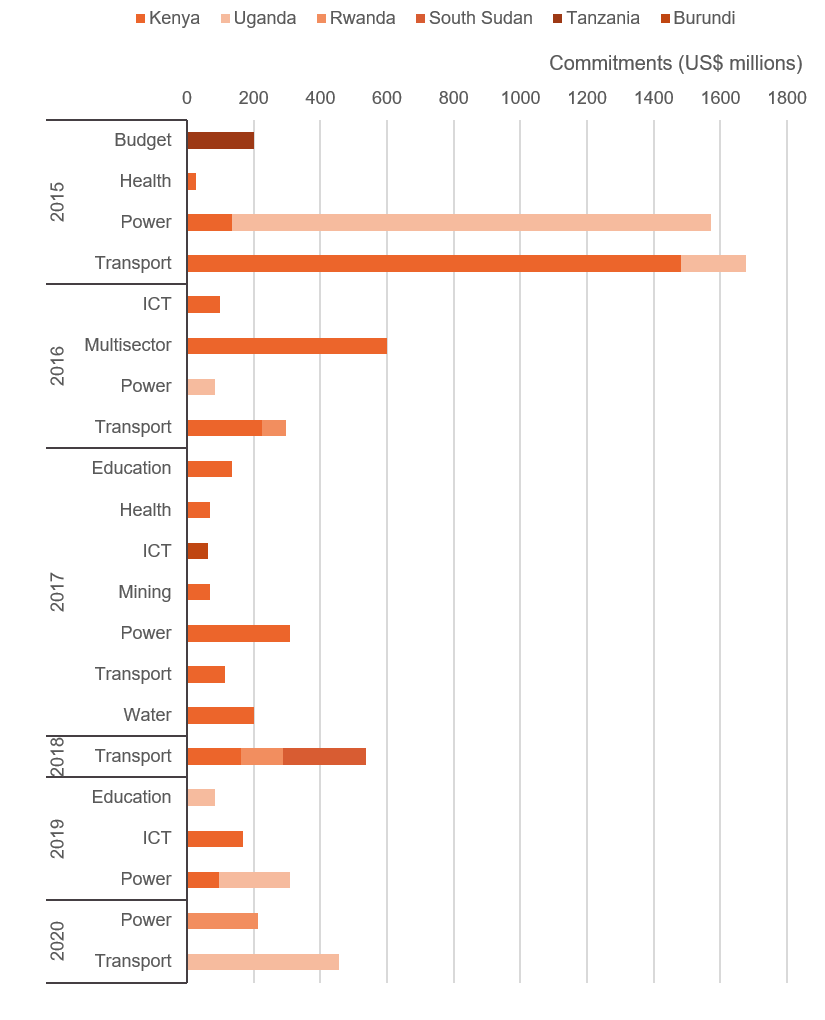Chinese lending to East Africa: What the numbers tell us
DI identifies key trends in Chinese lending to East Africa from 2015–2020 and examines China's rising influence in the region using SAIS-CARI and OECD data.
DownloadsIntroduction
Chinese loans to East Africa increased between 2010 and 2015 before gradually dropping during the second half of the decade to 2020. China committed a total of US$7.3 billion to Burundi, Kenya, Rwanda, South Sudan, Tanzania and Uganda between 2015 and 2020. [1] The decrease could be due to debt sustainability concerns in some countries, as well as debt restructuring and planned shifts in the composition of the Chinese actors. [2]
Loan datasets on Chinese lending have been recently made available by the China Africa Research Initiative based in Johns Hopkins School of Advanced and International Studies (SAIS-CARI) and a team of researchers at AidData at the College of William and Mary. These datasets cover a period of 20 years and have information on sector lending and sources of financing across the East African countries between 2000 and 2020.
Our analysis focuses on the loan commitments made by China to Burundi, Kenya, Rwanda, South Sudan, Tanzania and Uganda between 2015 and 2020. It drills down into the sectoral funding to understand which sectors have had the most commitments and from which sources these commitments are drawn. It examines the Chinese terms of lending to East Africa and the type of financing they offer. In the latter sections, using data from the Organisation for Economic Co-operation and Development (OECD) and SAIS-CARI, we compare the trends between Chinese creditors and some other top donors to East Africa.
It is important to mention that while we acknowledge that an analysis of both disbursement and commitments would give an overall picture of the lending situation in East Africa, we only have commitment data from China, hence limiting our scope of analysis.
Box 1
About the data in this factsheet
This analysis relies on data published by SAIS-CARI on Chinese loan commitments to Africa from 2000–2020, tracking commitments from Chinese policy and commercial banks, government entities, companies and other financiers to African governments and state-owned enterprises. The data sources include official government documents, contractor websites, fieldwork, interviews and media sources. In this paper we look at total loan commitments – both concessional and non-concessional – with a focus on six East African countries (Kenya, Uganda, South Sudan, Tanzania, Rwanda and Burundi) over a six-year period beginning in 2015 and ending in 2020. The figures shown are not equivalent to African government debt, as the database does not track disbursement or repayment. It is possible that more loan commitments will be published post-2020, however our focus is on data published between 2015 and 2020.
The analysis also benefits from the data from Organisation for Economic Co-operation and Development (OECD) published between 2015–2020 which is used to compare the trends between Chinese creditors and some other top donors to East Africa.
Key facts
- China’s lending portfolio in East Africa is driven by loan commitments to Kenya and Uganda. Between 2015 and 2020, China committed US$7.3 billion to East African countries. Commitments to Uganda and Kenya accounted for 87.3% of the total loans to the region. [3]
- Loan commitments over this period have been sourced from two banks and one private company: Exim Bank, China Development Bank and Huawei Technologies Co., Ltd. Exim Bank has been the major financier, providing 87.3% of the total commitments from China to East Africa.
- Both concessional and non-concessional loans are offered by China, the bulk of loans being concessional (87.3%). Concessional loans are mainly extended by Exim Bank and offered at below-market interest rates with longer grace periods.
- Funding goes mainly to two sectors across the East African countries: transport and power. These sectors account for 42.3% and 34.2% of total commitments to East Africa respectively between 2015 and 2020.
- China was the second largest loan provider to East Africa during the period of analysis. China is currently second only to the World Bank in aggregated loan commitments between 2015 and 2020. The World Bank provided US$1.3 billion to East African countries during the period analysed. EU institutions have committed US$256.7 million to East Africa, representing only 4% of China’s loans to East Africa during this period.
- The opacity of Chinese lending makes comparisons with peer creditors difficult. Transparent information on repayment safeguards and debt-restructuring flexibility in available initiatives is required to determine the quality of China’s lending.
China’s loans to continental Africa
A review of existing literature based on the recently released datasets on Chinese financing shows that much analysis of Chinese loans has been carried out at continent level, with no particular focus on the East Africa region. This study aims to fill that knowledge gap. Firstly, East African countries feature heavily among the list of the top recipients with huge volumes of aid from China. We therefore want to understand, backed by evidence, how much of the aid is going to East Africa, which sectors (apart from infrastructure) aid has gone to and what the terms of financing extended to these countries are. Secondly, the analysis will offer local civil society and advocacy organisations evidence on mounting debt in the region. This factsheet intends to start conversations and provide evidence relating to Chinese lending and terms of financing, which have previously been opaque subjects.
According to Fuchs and Rudyak (2019), China’s loan governance structure is composed of three leading governmental agencies: the Ministry of Commerce, the Ministry of Foreign Affairs, and the Ministry of Finance. The Ministry of Finance manages the country’s aid portfolio and budget and is responsible for China’s financial contribution to multilateral development agencies and banks. The Ministry of Foreign Affairs coordinates aid policy formation and annual planning with the Ministry of Commerce, including alignment of the broader agenda of foreign policy. However, in 2018 the China International Development Cooperation Agency (CIDCA) was introduced to replace the Ministry of Commerce as the major bureau to coordinate Chinese foreign aid. [4]
China’s debt portfolio in Africa in the last decade has remained significant compared to other traditional large donors to Africa. However, between 2017 and 2019 loans dipped, due to China’s cautious outlook on debt sustainability in some African countries such as Djibouti, Angola, Congo and Cameroon, [5] as well as debt restructuring and planned shifts in the composition of the Chinese actors. [6] The fall in loans is expected to continue through 2020 as a result of the pandemic and associated economic downturn, but then ease after 2020 due to the increasing demand for infrastructure in Africa and the profit expectations from financiers in China, which are mainly banks. [7]
According to the China Africa Research Initiative, Chinese lending to Africa is becoming increasingly commercialised. [8] In 2000 there was only one commercial lender – Exim Bank – which offered loans at below-market rates, but by 2019 there were over 30 commercial creditors to Africa including China Development Bank (CDB), the Industrial and Commercial Bank of China (ICBC), the Bank of China, and other non-financial entities. Post-2021, apart from being more commercialised, China will mostly rely on newer sources of financing including Chinese banks and companies, buyers’ credits and reallocation of its Special Drawing Rights (SDRs), which were included as part of its Forum on China–Africa Cooperation 2021 commitments.
Sectoral focus remained largely the same before and after 2015 but will likely shift during the current decade that began in 2021. China’s focus in Africa has been on infrastructure, particularly power and transport, in response to the increasing demand from African governments for infrastructure projects. With the reported reduction in funding from China between 2017 and 2020, and China’s imminent shift in priorities away from infrastructure, however, Africa will likely face an infrastructure funding gap. [9] There are signs that China will shift its priorities to focus on digital innovation, poverty reduction and agriculture, and trade. This was evident in the keynote speech that the Chinese president delivered during the Forum on China–Africa Cooperation 2021, outlining China’s priorities to Africa post-2021. In addition to its three updated priorities, moving forward China will also focus on health, green development, capacity building, people-to-people exchange, and peace and security. [10]
Chinese terms of lending are becoming increasingly sophisticated and opaque to manage high-risk borrowers. According to AidData, between 2000 and 2009 China had only one contract with a confidentiality clause among all its loans committed to Africa; however, between 2010 and 2019 several of its contracts included confidentiality clauses. Some of these confidential clauses featured: [11]
- More elaborate repayment safeguards than their peers in the official credit market.
- A clause to keep contract terms undisclosed unless otherwise required by law.
- A requirement to maintain an escrow account and other special bank accounts to secure debt repayment.
- Exclusion of the debt from restructuring in the Paris Club of official bilateral creditors and other collective restructuring initiatives.
- A requirement to allow the lender to terminate the agreement and demand immediate full repayment if the borrower defaults on its other lenders.
China’s lending portfolio in East Africa is driven by loan commitments to Kenya and Uganda
- China’s lending portfolio in the six East African countries between 2015 and 2020 is dominated by loan commitments to Kenya, followed by Uganda ( Figure 1 ). During this period, commitments to these two countries accounted for 87.3% of the total loans to East Africa.
- Cumulatively, commitments to East Africa from China have been declining steadily from US$3.5 billion in 2015 to just US$0.6 billion in 2020 – an 80.7% drop. Kenya, which is the fourth highest recipient of Chinese loans in Africa overall and the highest recipient in East Africa between 2015–2020, is the only East African country that has consistently received loans during the last five years, with the exception of 2020. However, loans to Kenya declined between 2015 and 2018, only increasing 64.1% in 2019. This could be a pointer to debt-sustainability concerns and recent debt restructuring. [12]
- Uganda, the second highest recipient of Chinese loans in East Africa – accounting for 33.9% of loans in the last five years, also experienced a significant decrease. Between 2015 and 2016, Chinese lending fell by 94.8%, stopped completely in 2017 and 2018, and jumped to US$297.4 in 2019 and US$456.4 million in 2020.
- During the 2015–2020 period, Tanzania, Burundi and South Sudan only received loan commitments from China in one year – Tanzania (2015), Burundi (2017), South Sudan (2018) – while Rwanda received loan commitments in three years: 2016, 2018 and 2020.
Figure 1: Kenya and Uganda received 87.3% of the total commitments channeled to East Africa between 2015 and 2020
Chinese lending by country and year, 2015–2020
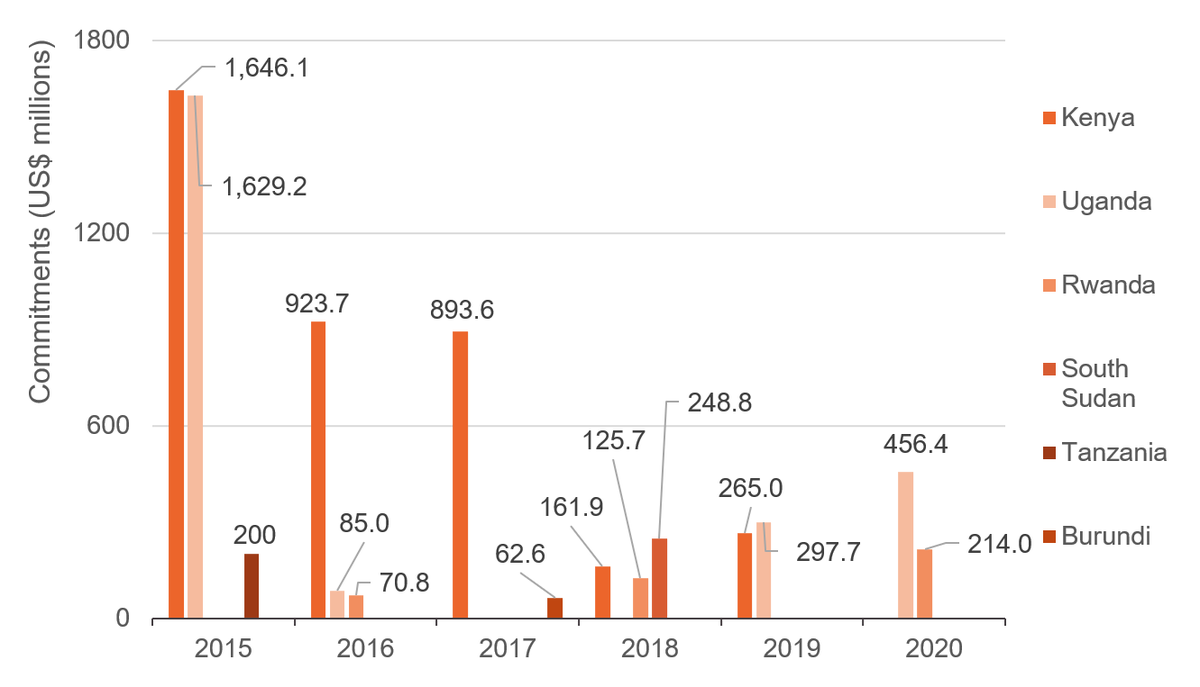
Bar chart showing that Kenya and Uganda received 87.3% of the total commitments channeled to East Africa between 2015 and 2020.
| Country | 2015 | 2016 | 2017 | 2018 | 2019 | 2020 |
|---|---|---|---|---|---|---|
| Kenya | 1646.12 | 923.65 | 893.6404 | 161.9235 | 264.961 | 0 |
| Uganda | 1629.2 | 84.983 | 297.74 | 456.365 | ||
| Rwanda | 70.80292 | 125.66 | 214 | |||
| South Sudan | 248.8 | |||||
| Tanzania | 200 | |||||
| Burundi | 62.6 |
Source: Development Initiatives based on SAIS-CARI data.
Loan commitments over this period have been sourced from two banks and one private company
- Despite the increasing number of Chinese commercial creditors in Africa between 2015–2020, loan commitments to the East African region have been sourced from only two banks (Exim Bank and CDB) and one private company (Huawei Technologies Co., Ltd), which exclusively funded a project in Burundi in 2017.
- Exim Bank is responsible for over four fifths (87.3%) of the financing; the bank is the biggest source of loans from China to East Africa and across the African continent. [13] It gave over seven times more than the share of loans from CDB Bank (12.3%). Huawei Technologies Limited, which was the only non-bank financier, extended 0.4% in loan commitments to the region.
Figure 2: Four fifths of the total loan commitments between 2015–2020 were sourced from Exim Bank
Sources of financing from China to East Africa, 2015–2020
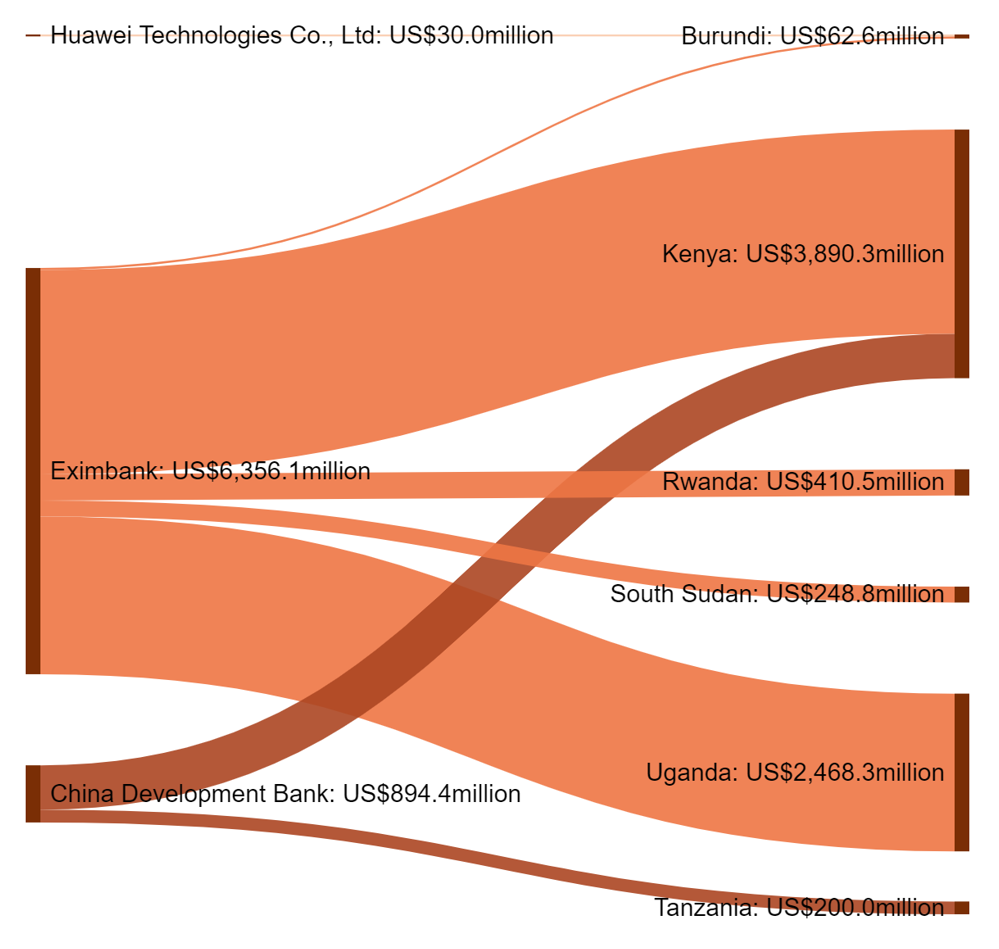
Chart showing that four fifths of the total loan commitments between 2015–2020 were sourced from Exim Bank
| CDB | Eximbank | Huawei Technologies Co., Ltd. | |||
|---|---|---|---|---|---|
| Burundi | 32.6 | 30 | |||
| Kenya | 694.42 | 3195.875 | |||
| Rwanda | 410.4629 | ||||
|
South
Sudan |
248.8 | ||||
| Tanzania | 200 | ||||
| Uganda | 2468.288 |
Source: Development Initiatives based on SAIS-CARI data.
Both concessional and non-concessional loans were offered by China from 2015 to 2019; the bulk of loans were concessional
- Between 2015 and 2020, both concessional and non-concessional loans were offered to East African countries. Concessional loans (87.3%) accounted for most Chinese lending; these loans were mainly extended by Exim Bank and offered at below-market interest rates with maturity and grace periods from 25 to 30 years. The Chinese government subsidised most of these loans, hence the reduced market rates. Soft terms are intended to attract middle- and low-income African countries with debt-sustainability issues and an urgent need to develop infrastructure to channel wealth creation.
- Non-concessional loans, which accounted for 12.7% of total loans, were extended to Burundi, Kenya and Tanzania by CDB and the non-financial entity, Huawei Technologies Co., Ltd.
- Data from SAIS-CARI indicates that while most funding from Exim Bank was advanced at concessional rates due to government subsidies to the banks, other lenders, such as CDB and non-financial agencies purely lend on non-concessional terms.
Figure 3: 87.3% of the total loan commitments to East Africa were concessional
Terms of financing for Chinese loans to East Africa, 2015–2019
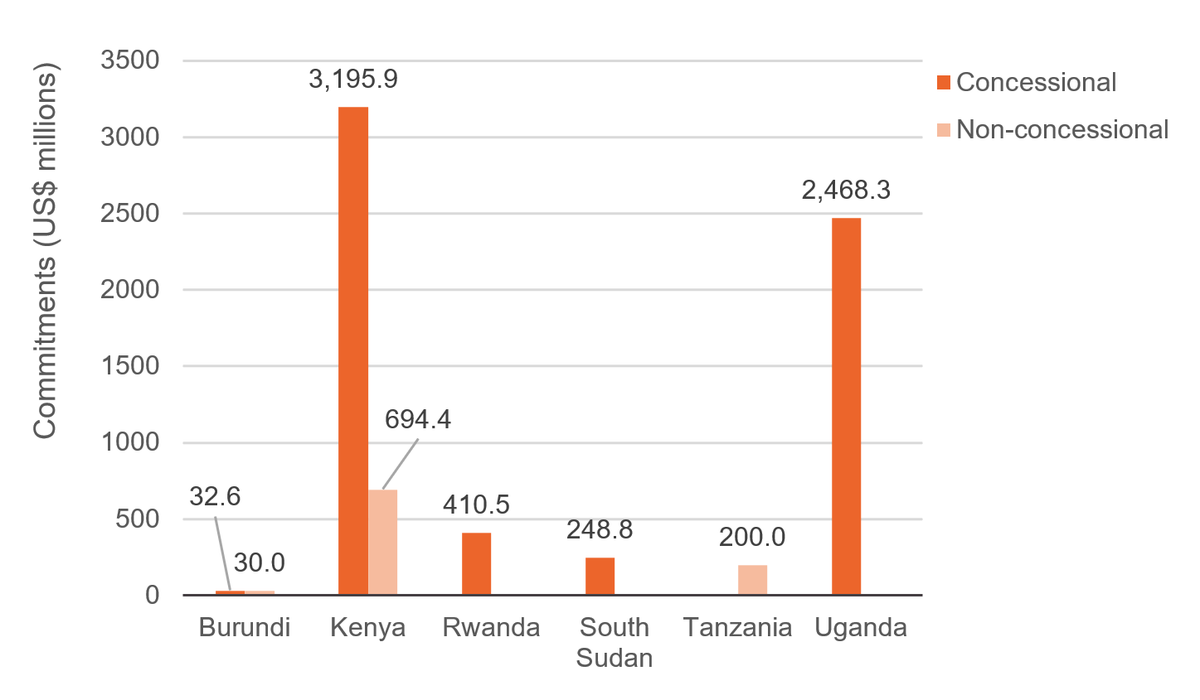
Bar chart showing that 87.3% of the total loan commitments to East Africa were concessional
| Concessional | Non-concessional | |
|---|---|---|
| Burundi | 32.6 | 30 |
| Kenya | 3195.874875 | 694.42 |
| Rwanda | 410.462919 | |
| South Sudan | 248.8 | |
| Tanzania | 200 | |
| Uganda | 2468.288194 |
Source: Development Initiatives based on SAIS-CARI data.
Funding goes mainly to two sectors across the East African countries: transport and power
- Between 2015–2020, total loan commitments from China to East African countries were concentrated in two sectors – transport and power. Transport accounted for slightly over two fifths (42.3%) of China’s total loan commitments to East Africa, while power took slightly over a third (34.2%).
- Country-focused analysis reveals that while Burundi and Tanzania channeled 100% of the loans to ICT and budget support respectively, the remaining countries focused on transport (South Sudan, 100%, and Kenya, 51%) or power (Uganda, 70.2%, and Rwanda, 52.1%).
- The concentration of funding could be attributed to the resource-backed model of lending policy that China applies to most of its loan commitments. This policy requires that borrowing countries commit future revenues earned from projects commissioned by China to pay loans secured by Chinese creditors. [14] Therefore, bigger projects, especially in transport and power, are more likely to secure the projected revenues.
- The lending model has helped high-risk borrowing countries to secure loans, complete large-scale projects and provide assurance to the creditors of repayment. In the event of erratic economic phenomena such as commodity price fluctuations that may lead to defaulting repayment, the lender bears the risk of debt default since the range of price fluctuations are calculated in the loan.
- Analysis by lending institutions reveals that while most concessional funds given by Exim Bank were channeled to the power and transport sectors, funds from CDB, which are non-concessional, were mostly spent on multi-sector projects. Funding from Huawei Technologies Co., Ltd, which also advances non-concessional loans, were all concentrated in the ICT sector.
China was the second largest loan provider to East Africa during the period of analysis
This section compares China’s loan commitments to East Africa with other top donors to the region including the UK, US, World Bank (International Development Association [IDA]) and EU institutions. For comparison purposes we have included OECD data showing the total loan commitments made by the UK, US, World Bank (IDA) and EU institutions. A caveat is that some of the traditional big donors such as the US and UK are yet to extend any ODA loan commitments to countries in East Africa, while others have only extended commitments to a few countries.
- Analysis shows that while China’s commitments have contracted, commitments from the rest of the top donors have been less consistent. Aside from increases of 4.9% in 2019 and 19.1% in 2020, loan commitments from China were shown to be generally shrinking during the study period.
- Analysis of the other traditional donors indicates that while most of their financing to East African countries has been in the form of grants as opposed to loans, China has mainly advanced loans .
- EU institutions advanced a total of US$256.7 million in loans between 2015 and 2019. The bulk of this was given to Burundi (US$78.4 million) and Tanzania (US$122.9 million). Funding from EU institutions was highly erratic during this period, alternating between increases and decreases, with the biggest increase in 2019 (155%) and the biggest decrease in 2018 (27.7%). Moreover, East African countries did not receive any funding commitment from the EU in 2020.
- Similarly, lending to East Africa by the World Bank significantly dipped during the 2015–2020 period. Funding decreased by 96.1% between 2015 and 2017 before rising by 253% in 2018. Thereafter, funding decreased consistently in 2019 and 2020 (by 36% and 41% respectively). Notably, Burundi and South Sudan are yet to receive any funding in the form of World Bank (IDA) loans during this period. The main recipients have been Tanzania (US$3.4 billion), Kenya (US$3.0 billion) and Rwanda (US$2.1 billion).
- Comparative analysis of the terms of financing offered by China and the traditional donors reveals relatively strong resemblance. Most loans advanced by China were concessional (87.3%) with just a small proportion, especially those provided by the CDB and non-financial entities, being non-concessional. Similarly, traditional donors, World Bank (IDA) and EU institutions provide bulk of loans at concessional rates.
- China’s increasing influence in East Africa is evident. As a loan provider to East Africa, China is second only to the World Bank, which has loaned US$1.3 billion to East African countries during the period analysed. EU institutions have advanced US$256.7 million in loans to East Africa; this represents only 4% of China loans to East Africa between 2015 and 2020.
- Sectoral concentration differs when comparing China to other top donors. While China mostly lends to the transport and energy sectors, the rest of the top donors mainly lend to social, economic and governance sectors, such as health, education, agriculture, and governance and security. However, it should be noted that the World Bank has also financed major transport infrastructure projects in Kenya and Uganda.
- China has capitalised on countries that seek concessional loans and suitable terms. China presents an alternative infrastructural resource, such as for roads, for countries in debt distress.
Figure 5: While loan commitments from China have been shrinking, those from traditional donors have been erratic
Loan commitments to East Africa by China and other top donors, 2015–2020
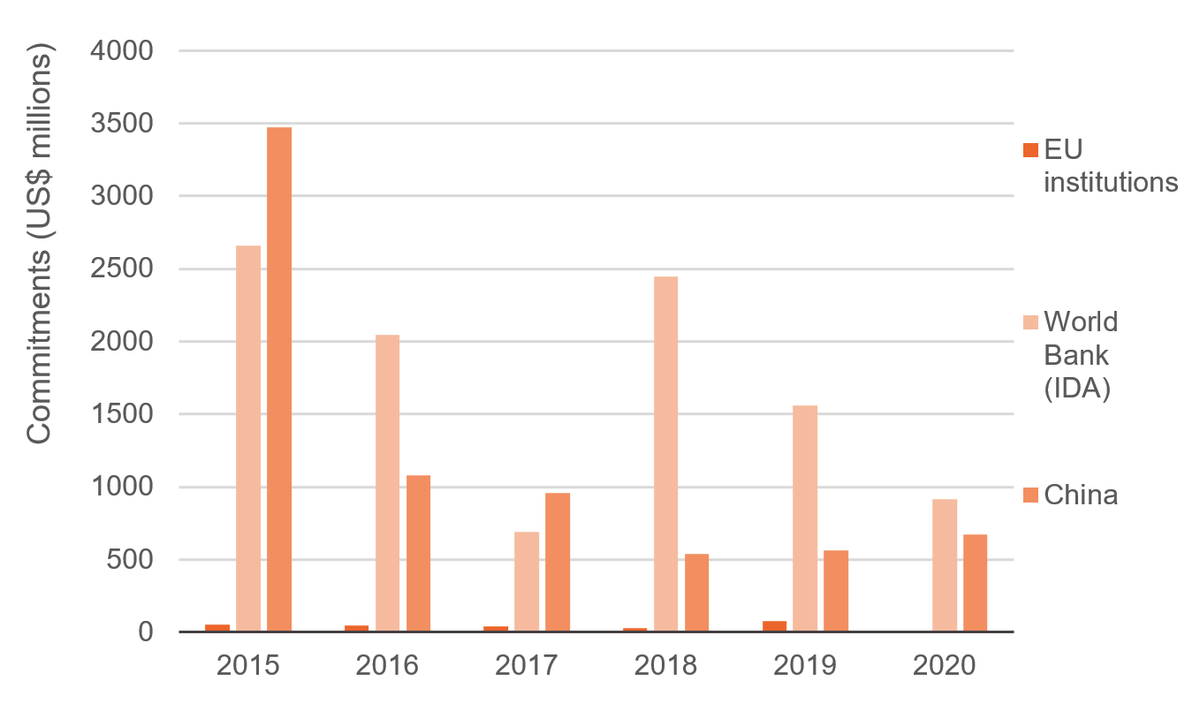
Bar chart showing that while loan commitments from China have been shrinking, those from traditional donors have been erratic.
| 2015 | 2016 | 2017 | 2018 | 2019 | 2020 | |
|---|---|---|---|---|---|---|
| EU institutions | 46.697 | 69.708 | 42.434 | 30.685 | 67.839 | 59.636 |
| World Bank (IDA) | 1606.037 | 1292.749 | 1696.659 | 1816.874 | 2,751.01 | 3,384.64 |
| China | 3475.32 | 1079.436 | 956.2404 | 536.3835 | 562.701 | 670.365 |
Source: Development Initiatives based on SAIS-CARI and OECD data.
The opacity of Chinese lending makes comparisons with peer creditors challenging
Five East African countries – Kenya, Uganda, Burundi, Tanzania and Rwanda – have produced debt reports in the years reviewed. Though South Sudan has not produced a debt report in the period of analysis, there is evidence from the IMF’s report in 2017 on the debt sustainability status of South Sudan which can be used as reference. Data from the recent country debt reports is inconsistent with the data on SAIS-CARI. While the data on SAIS-CARI shows loan commitments, country debt reports show limited information on loan commitments. This is our summary of the key emerging messages from publicly available documents:
- According to country debt reports, China remains a major creditor across East Africa . Kenya’s annual public debt report acknowledges that China has a 19.9% share of the total aid from creditors; this is second only to IDA. [15] In contrast, Uganda’s debt report indicates that China dominates the bilateral debt composition with 74% of the total bilateral lending as of 31 December 2020. [16] The Rwanda Medium Debt Strategy 2019/20–2021/22 identifies China as the fourth biggest creditor after multilateral institutions (such as the IMF, IDA and IFAD), US and Europe. [17] Tanzania’s recent debt report states that China is its third largest creditor with increasing influence from 2016 onwards with the advent of its standard-gauge railway loan in 2016/17. In Burundi, China is the third-largest lender as of 2019; [18] in South Sudan, a report published by the IMF on the country’s debt-sustainability status acknowledges that by 2016 China had remitted US$100 million to South Sudan for the reconstruction of Juba International Airport – this was the country’s only aid funding from a donor in 2016.
- Reports acknowledge that a large portion of Chinese lending funded projects related to infrastructure, particularly roads and railways. This is consistent with our finding from the China loans data indicating that over two fifths of Chinese loans between 2015–2020 were channelled to the transport sector.
- There is a general mismatch between data produced in these reports and the data from China used in the analysis. This difference could originate in the use of different reporting methods (disbursement versus commitments) in the reports. The China loan data from SAIS-CARI shows loan commitments while the country reports use disbursements for reporting. Moving forward, it will be important for both the lender and the recipient to make information available on both disbursement and commitment that will be useful for accountability and transparency.
- Countries including Kenya, Tanzania, Rwanda, Burundi and Uganda provide information on national debt (loan disbursements, debts servicing including the interest rates and maturity periods and debt sustainability status), but omit some useful details, such as loan contracts, from their reports. These details would assist in providing information to build a robust analysis of the East African countries’ loans. This is likely to be due to confidentiality clauses in some of its loan contracts.
Conclusion
Even with the recent commitment of G7 leaders to raise US$600 billion to rival China’s infrastructure initiative in Africa and other developing countries, China’s debt in East Africa will continue to mount, at least in the near future. East African countries do not have an alternative form of financing for large-scale projects on transport and energy in the foreseeable future. These are sectors that are seen as the important drivers of sustainable development.
Our analysis established that China mostly lends to infrastructure and power projects in East Africa. These projects usually focus on roads, rail and power, with payments often guaranteed by project revenues. While this resource-backed lending model is considered controversial by some, [19] it allows high-risk borrowing countries to secure much-needed financing, assures the creditor of repayment, and allows for the speedy completion of infrastructure projects. However, concerns that debt sustainability might lead to borrowing from other sources to repay loans are valid.
The bulk of Chinese financing to East Africa has come from Exim Bank, which offers loans on concessional terms. This may continue in the short term, but China appears to be moving from concessional to more commercial terms of financing. This is backed by evidence on increasing commercial creditors offering non-concessional loans to Africa and, to some extent, East Africa.
Our analysis reveals that while there are sectors, including infrastructure, where China has made inroads, other sectors, such as the social sector, have been predominantly occupied by traditional donors including the World Bank and EU institutions. It remains to be seen whether China will move to digital innovation, agriculture and poverty reduction, and trade as reiterated by its president during the Forum on China–Africa Cooperation 2021. [20]
While this is the first time we have data, more transparency and better publicly available information are needed to test assumptions. Data analysis would benefit from further access to information on the quality of Chinese loans, China’s approach to country debt sustainability, and measures put in place to ensure responsible borrowing from African countries.
Downloads
Notes
-
1
Only six countries in East Africa were considered for this analysis – Kenya, Uganda, Tanzania, Burundi, Rwanda and South Sudan. DRC, which recently became part of East African Community, was yet to be commissioned into the EAC at the time of reporting.Return to source text
-
2
Carnegie. What do we know about Chinese lending to Africa? Available at: https://carnegieendowment.org/2021/06/02/what-do-we-know-about-chinese-lending-in-africa-pub-84648 (Accessed on 23 June 2022)Return to source text
-
3
Only six countries were considered for this analysis – Kenya, Uganda, Tanzania, Burundi, Rwanda and South Sudan. At the time of reporting, DRC, which joined officially the EAC in March 2022, is yet to deposit the necessary instruments to become the official seventh Partner State of the EAC.Return to source text
-
4
Rudyak, Marina and Fuchs, Andreas, 2019. The Motives of China’s Foreign Aid. Available at: http://www.andreas-fuchs.net/uploads/1/9/8/9/19897453/fuchs_rudyak_chinas_aid_motives__website_.pdfReturn to source text
-
5
The Hong Kong Trade Development Council, 2021. Risky Business: New Data on Chinese Loans and Africa’s Debt Problem. Available at: https://research.hktdc.com/en/article/Njk1Nzc1NTQz (Accessed on 25 April 2021)Return to source text
Related content
Donors at the triple nexus
DI Senior Policy & Engagement Advisor Sarah Dalrymple presents some of our recent analysis into how donors like Sweden and the UK are approaching the triple nexus between humanitarian, development and peace approaches in crisis contexts.
Implications of coronavirus on financing for sustainable development
DI Executive Director Harpinder Collacott summarises the possible impacts of the coronavirus pandemic on global development - including projections for extreme poverty, the future of different forms of financing, and the countries likely to be most impacted.
What do emerging trends in development finance mean for crisis actors?
DI's webinar ‘What do emerging trends in development finance mean for crisis actors?’ gives crisis actors key information on development finance to better understand what it means for them.
